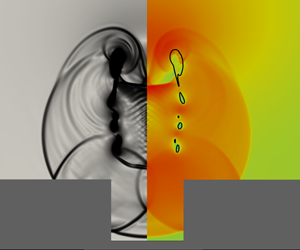No CrossRef data available.
Published online by Cambridge University Press: 21 July 2020

The impact of a collapsing gas bubble above rigid, notched walls is considered. Such surface crevices and imperfections often function as bubble nucleation sites, and thus have a direct relation to cavitation-induced erosion and damage structures. A generic configuration is investigated numerically using a second-order accurate compressible multi-component flow solver in a two-dimensional axisymmetric coordinate system. Results show that the crevice geometry has a significant effect on the collapse dynamics, jet formation, subsequent wave dynamics and interactions. The wall-pressure distribution associated with erosion potential is a direct consequence of development and intensity of these flow phenomena.
Smooth wall (no crevice, $R_C= 0$), attached bubble $S/R_0 = 0.35$. See caption Movie 1.
Smooth wall (no crevice, $R_C= 0$), attached bubble $S/R_0 = 0.6 $. See caption Movie 1.
Smooth wall (no crevice, $R_C= 0$), detached bubble $S/R_0 = 1.1 $. See caption Movie 1.
Small crevice ($R_C/R_0= 0.15$), attached bubble $S/R_0 = 0.1 $. See caption Movie 1.
Small crevice ($R_C/R_0= 0.15$), attached bubble $S/R_0 = 0.35$. See caption Movie 1.
Small crevice ($R_C/R_0= 0.15$), attached bubble $S/R_0 = 0.6 $. See caption Movie 1.
Small crevice ($R_C/R_0= 0.15$), detached bubble $S/R_0 = 1.1 $. See caption Movie 1.
Large crevice ($R_C/R_0= 0.75$), attached bubble $S/R_0 = 0.1 $. See caption Movie 1.
Large crevice ($R_C/R_0= 0.75$), attached bubble $S/R_0 = 0.35$. See caption Movie 1.
Large crevice ($R_C/R_0= 0.75$), attached bubble $S/R_0 = 0.6 $. See caption Movie 1.